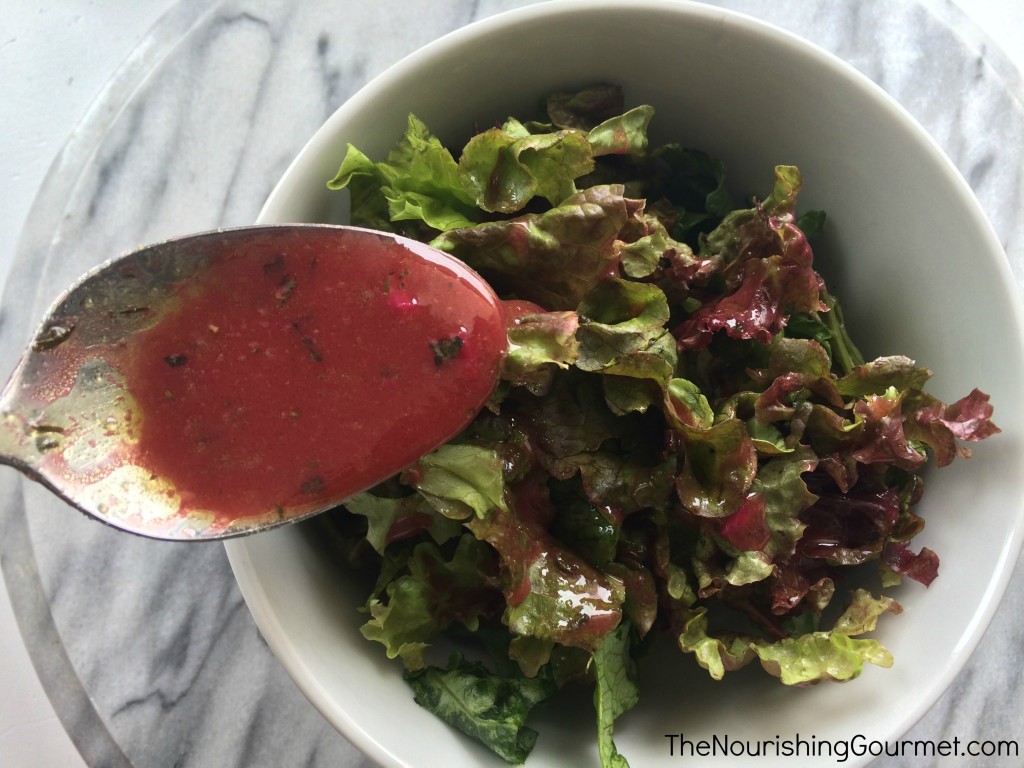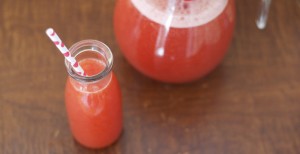By April Swiger, Contributing Writer
Some of the most beautiful stains on my cutting board are from beets. Tangy, earthy, salty, and a little bit of fizz perfectly describe this deeply nourishing, and richly medicinal, fermented beet kvass tonic. It’s an acquired taste, which I have slowly become accustomed to, and I have fallen head over heels for this blood red drink. Traditionally, tonics like this supplemented the daily diet, instead of supplement pills.
(Disclaimer: Some links may be affiliate links, and this site has an affiliate association with Amazon)
Sally Fallon in Nourishing Traditions says (page 610): “This drink is valuable for its medicinal qualities and as a digestive aid. Beets are just loaded with nutrients. One 4-ounce glass, morning and night, is an excellent blood tonic, promotes regularity, aids digestion, alkalizes the blood, cleanses the liver and is a good treatment for kidney stones and other ailments.”
According to this article by the Weston A. Price Foundation, kvass originated in Russia and was traditionally made with stale sourdough rye bread. It boasted of great immune boosting qualities, and although it wasn’t an alcoholic drink, it was similar to beer in taste. Kvass can also be made with beets, and traditional homes in the Ukraine always had a bottle on hand. It was often used as a tangy addition in soups, vinaigrettes, and borscht.
The health benefits of lacto-fermented food are undeniable. As chopped beets mix with sea salt, the sugar and starch convert to lactic-acid perfectly preserving the kvass. The finished drink is full of beneficial enzymes, friendly probiotic bacteria, and increased vitamin levels. Regularly eating lacto-fermented vegetables, or incorporating beet kvass into your diet, will promote healthy gut flora, and greater absorption of nutrients from your food.
The first time I made beet kvass, I used Sally Fallon’s recipe in Nourishing Traditions which calls for the addition of whey to inoculate the mixture. We don’t eat much dairy in our home, so I opted to double the salt, and ferment my kvass for longer than the recommended two days. The end result was way too salty! However, after it sat in the refrigerator for a few more days, the saltiness diminished quite a bit, and I was able to drink it and enjoy it.
Wild fermentation is truly an art, and takes a little trial and error. In recent months I experimented with decreasing the amount of salt in my kvass while still using enough to allow proper fermentation to take place. My most recent batch was the fizziest yet and absolutely delicious! Depending on the time of year, and the temperature inside your home, your kvass may need anywhere from 2-7 days to ferment. This winter I’ve been allowing mine to sit at room temperature for a full week before putting it in the refrigerator.
Fermentation Vessel Choice
There has been some debate about what the best vessel is for lacto-fermentation. Wardee at GNOWFGLINS breaks down some great options. I personally have always used a mason jar with a metal band and lid. None of my ferments have ever gotten moldy (mold isn’t necessarily a bad thing), and I typically burp them once a day to release the pressure that builds up. This works for me, but it’s good to explore other options that may better suit your personal preferences.
Foam/Scum on Top
A few times my kvass has developed a thin layer of white or brown foam at the top. It’s harmless, and I typically scoop it out with a spoon before putting my jar in the refrigerator.
Filtered Water
It’s very important to use filtered water, free from chemicals like chlorine and fluoride. These chemicals are typically present in tap water and can prevent your kvass from fermenting properly. I have been using a Berkey filter for two years now, and love it.
Sea Salt
Celtic sea salt is my salt of choice. It’s unrefined and packed full of nutrients and trace minerals. Standard table salt has iodine added to it, which could inhibit the growth of beneficial bacteria. Table salt is not a good choice for fermenting beet kvass, so it’s best to go with an unrefined sea salt.
How will I know when my beet kvass is ready?
When the kvass is a deep red color, and you see fizzy bubbles moving upwards in the jar, it’s good for drinking! It should smell earthy and salty, like beets. If it smells rancid, throw it out. Your nose will know, so don’t drink anything that smells off. If your home is fairly warm (over 72 F), your kvass is likely ferment quickly, so keep an eye on it. I let mine go for a week during the winter, and only a few days during the warmer months.
You can also use your beets for a second, weaker batch. Save about half a cup of the kvass in your jar as a “starter”, fill it with filtered water again, and set it out on your counter for a few days. Your kvass will last for many months in the refrigerator.
Other Uses
You can use your kvass in place of vinegar for salad dressings, or as a tangy addition to soups. Be sure to reduce any additional salt in your recipe! A recent favorite of mine is adding beet kvass to Kimi’s everyday salad dressing recipe in place of apple cider vinegar. The color is beautiful!
Other Lacto-fermented Recipes:
- Old Fashioned lacto-Fermented Sauerkraut
- Lacto-Fermented Dilly Carrot Sticks (I’ve made this one and it’s incredibly easy and delicious!)
- Lacto-Fermented Roasted Tomato Salsa
- Lacto-Fermented Escabeche

- 2 large, or 3-4 medium beets (preferably organic)
- 1 tablespoon of sea salt
- Filtered water
- Peel your beets, and chop them up coarsely (1-2 inch chunks). Do not grate your beets! This will cause your kvass to ferment too rapidly, producing alcohol rather than lactic-acid (Sally Fallon, Nourishing Traditions, page 610)
- Put your chopped beets in your jar, or divide them equally between two quart sized jars
- Sprinkle the sea salt on top of your beets
- Fill your jar with filtered water, leaving about an inch at the top for headspace, and stir the contents well
- Secure the lid, and leave it on your counter for 2-7 days before moving it to the refrigerator



